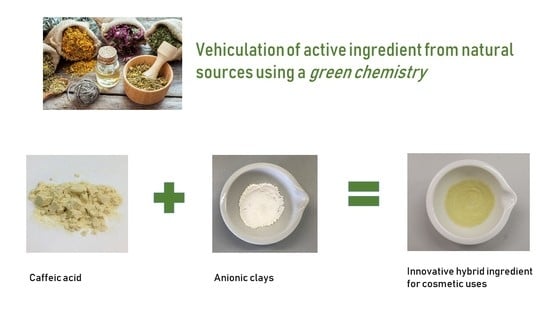Caffeic Acid-layered Double Hydroxide Hybrid: A New Raw Material for Cosmetic Applications
Abstract
:1. Introduction
2. Materials and Methods
2.1. Chemicals and Solvent
2.2. ZnAl-ACE Preparation
2.3. ZnAl-CAF Preparation
2.4. Sample Characterization
2.4.1. Inductively Coupled Plasma-Optical Emission Spectrometer (ICP-OPES)
2.4.2. Thermal Analysis
2.4.3. UV-Visible Double-Beam Spectrophotometer
2.4.4. FT-IR Analysis
2.4.5. Caffeic Acid Content in ZnAl-CAF
2.4.6. X-ray Powder Diffraction
2.4.7. Franz Cell Release
2.4.8. Antioxidant Activity
3. Results and Discussion
3.1. LDHs Characterization
3.2. In Vitro Release Studies
3.3. Antioxidant Activity
4. Conclusions
Author Contributions
Funding
Acknowledgments
Conflicts of Interest
References
- Clifford, M.N. Chlorogenic acids and other cinnamates nature, occurrence, dietary burden, absorption and metabolism. J. Sci. Food Agric. 2000, 80, 1033–1043. [Google Scholar] [CrossRef]
- Teixeira, J.; Gaspar, A.; Garrido, E.M.; Garrido, J.; Borges, F. Hydroxycinnamic acid antioxidants: An electrochemical overview. BioMed Res. Int. 2013, 2013. [Google Scholar] [CrossRef] [PubMed]
- Chung, T.W.; Moon, S.K.; Chang, Y.C.; Ko, J.H.; Lee, Y.C.; Cho, G.; Kim, S.H.; Kim, J.G.; Kim, C.H. Novel therapeutic effect of caffeic acid and caffeic acid phenyl ester on hepatocarcinoma cells: Complete regression of hepatoma growth and metastasis by dual mechanism. FASEB J. 2004, 14, 1670–1681. [Google Scholar] [CrossRef] [PubMed]
- Xu, F.; Zhang, S.H.; Shao, R.G.; Zhen, Y.-S. Anticancer activity of sodium caffeate and its mechanism. Acta Pharmacol. Sin. 2005, 10, 1248–1252. [Google Scholar] [CrossRef] [PubMed]
- Toma, L.; Sanda, G.M.; Niculescu, L.S.; Deleanu, M.; Stancu, C.S.; Anca, V.; Sima, A.V. Caffeic acid attenuates the inflammatory stress induced by glycated LDL in human endothelial cells by mechanisms involving inhibition of AGE-receptor, oxidative, and endoplasmic reticulum stress. Biofactors 2017, 43, 685–697. [Google Scholar] [CrossRef] [PubMed]
- Cartron, E.; Carbonneau, M.A.; Fouret, G.; Descomps, B.; Léger, C.L. Specific antioxidant activity of caffeoyl derivatives and other natural phenolic compounds: LDL protection against oxidation and decrease in the proinflammatory lysophosphatidylcholine production. J. Nat. Prod. 2001, 64, 480–486. [Google Scholar] [CrossRef] [PubMed]
- Maurya, D.K.; Asir Devasagayam, T.P. Antioxidant and prooxidant nature of hydroxycinnamic acid derivatives ferulic and caffeic acids. Food Chem. Toxicol. 2010, 48, 3369–3373. [Google Scholar] [CrossRef] [PubMed]
- Leopoldini, M.; Chiodo, S.G.; Russo, N.; Toscano, M. Detailed Investigation of the OH Radical Quenching by Natural Antioxidant Caffeic Acid Studied by Quantum Mechanical Models. J. Chem. Theory Comput. 2011, 7, 4218–4233. [Google Scholar] [CrossRef] [PubMed]
- Kikuzaki, H.; Hisamoto, M.; Hirose, K.; Akiyama, K.; Taniguchi, H. Antioxidant Properties of Ferulic Acid and Its Related Compounds. J. Agric. Food Chem. 2002, 50, 2161–2168. [Google Scholar] [CrossRef] [PubMed]
- Magnani, C.; Isaac, V.L.B.; Correa, M.A.; Salgado, H.R.N. Caffeic acid: A review of its potential use in medications and cosmetics. Anal. Methods 2014, 6, 3203–3210. [Google Scholar] [CrossRef]
- Kim, S.R.; Jung, Y.R.; An, H.J.; Kim, D.H.; Jang, E.J.; Choi, Y.J.; Moon, K.M.; Park, M.H.; Park, C.H.; Chung, K.W.; et al. Anti-Wrinkle and Anti-Inflammatory Effects of Active Garlic Components and the Inhibition of MMPs via NF-κB Signaling. PLoS ONE 2013. [Google Scholar] [CrossRef] [PubMed]
- Taofiq, O.; González-Paramás, A.M.; Barreiro, M.F.; Ferreira, I.C.F.R. Hydroxycinnamic Acids and Their Derivatives: Cosmeceutical Significance, Challenges and Future Perspectives, a Review. Molecules 2017, 22, 281. [Google Scholar] [CrossRef] [PubMed]
- Choi, S.J.; Choy, J.H. Layered double hydroxide nanoparticles as target-specific delivery carriers: Uptake mechanism and toxicity. Nanomedicine 2011, 6, 803–814. [Google Scholar] [CrossRef] [PubMed]
- Mishra, G.; Dasha, B.; Pandey, S. Layered double hydroxides: A brief review from fundamentals to application as evolving biomaterials. Appl. Clay Sci. 2018, 153, 172–186. [Google Scholar] [CrossRef]
- Choy, J.H.; Choi, S.J.; Oh, J.M.; Park, T. Clay minerals and layered double hydroxides for novel biological applications. Appl. Clay Sci. 2007, 36, 122–132. [Google Scholar] [CrossRef]
- Bastianini, M.; Costenaro, D.; Bisio, C.; Marchese, L.; Costantino, U.; Vivani, R.; Nocchetti, M. On the Intercalation of the Iodine–Iodide Couple on Layered Double Hydroxides with Different Particle Sizes. Inorg. Chem. 2012, 51, 2560–2568. [Google Scholar] [CrossRef] [PubMed]
- Bhattacharyya, A.; Hall, D.B. Materials Synthesis and Characterization; Plenum Press: New York, NY, USA, 1997; Chapter 7. [Google Scholar]
- Jacobson, A.J.; Nazar, L.F. Intercalation Chemistry; Encyclopedia of Inorganic Chemistry: New York, NY, USA, 2006. [Google Scholar]
- Costantino, U.; Ambrogi, V.; Nocchetti, M.; Perioli, L. Hydrotalcite-like compounds: Versatile layered host of molecular anions with biological activity. Mesopor. Mat. 2008, 107, 149–160. [Google Scholar] [CrossRef]
- Wei, Y.; Gao, Y.; Zhang, K.; Ito, Y. Isolation of caffeic acid from Eupatorium Adenophorum Spreng by high-speed countercurrent chromatography and synthesis of caffeic acid-intercalated layered double hydroxides. J. Liquid Chromatogr. Relat. Technol. 2010, 33, 837–845. [Google Scholar] [CrossRef] [PubMed]
- Villaño, D.; Fernández-Pachón, M.S.; Moyá, M.L.; Troncoso, A.M.; García-Parrilla, M.C. Radical scavenging ability of polyphenolic compounds towards DPPH free radical. Talanta 2007, 71, 230–235. [Google Scholar] [CrossRef] [PubMed]
- Carlino, S. The intercalation of carboxylic acids into layered double hydroxides: A critical evaluation and review of the different methods. Solid State Ion. 1997, 98, 73–84. [Google Scholar] [CrossRef]
- Rossi, C.; Schoubben, A.; Ricci, M.; Perioli, L.; Ambrogi, V.; Latterini, L.; Aloisi, G.G.; Rossi, A. Intercalation of the radical scavenger ferulic acid in hydrotalcite-like anionic clays. Int. J. Pharm. 2005, 295, 47–55. [Google Scholar] [CrossRef] [PubMed]
- Biswick, T.; Park, D.H.; Choy, J.H. Enhancing the UV A1 screening ability of caffeic acid by encapsulation in layered basic zinc hydroxide matrix. J. Phys. Chem. Solids 2012, 73, 1510–1513. [Google Scholar] [CrossRef]
- Sun, W.; He, Q.; Lu, L.; Liu, H. Synthesis and properties of layered double hydroxides intercalated with cinnamic acid series organic UV ray absorbents. Mater. Chem. Phys. 2008, 107, 261–265. [Google Scholar] [CrossRef]
- NIST Chemistry WebBook, SRD 69. Available online: https://webbook.nist.gov/cgi/cbook.cgi?ID=C331395&Mask=80 (accessed on 2 June 2018).
- Siewert, M.; Dressman, J.; Brown, C.K.; Shah, V.P. FIP/AAPS Guidelines to Dissolution/In Vitro Release Testing of Novel/Special Dosage Forms. AAPS PharmSciTech 2003, 4. [Google Scholar] [CrossRef] [PubMed]
- Yang, J.H.; Lee, J.H.; Ryu, H.J.; Elzatahry, A.A.; Alothman, Z.A.; Choy, J.H. Drug–clay nanohybrids as sustained delivery systems. Appl. Clay Sci. 2016, 130, 20–32. [Google Scholar] [CrossRef]
- Perioli, L.; Pagano, C. Inorganic-Organic Hybrids to Improve the Performances of Anti-Inflammatory Topical Formulations. Int. J. Pharm. Rev. Res. 2016, 5, 1–18. [Google Scholar]
- Kong, X.; Jin, L.; Wei, M.; Duan, X. Antioxidant drugs intercalated into layered double hydroxide: Structure and in vitro release. Appl. Clay Sci. 2010, 49, 324–329. [Google Scholar] [CrossRef]
- Cunha, V.R.R.; Souza, R.B.; Martins, A.M.C.R.P.F.; Koh, I.H.J.; Constantino, V.R.L. Accessing the biocompatibility of layered double hydroxide by intramuscular implantation: Histological and microcirculation evaluation. Sci. Rep. 2016, 6. [Google Scholar] [CrossRef] [PubMed]
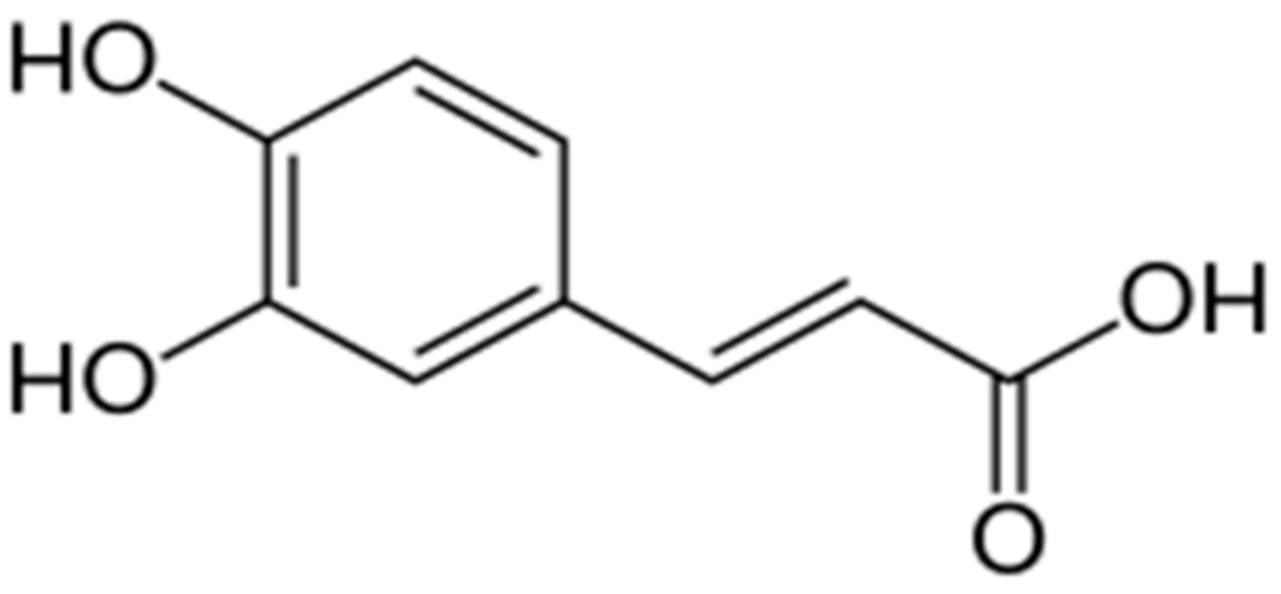
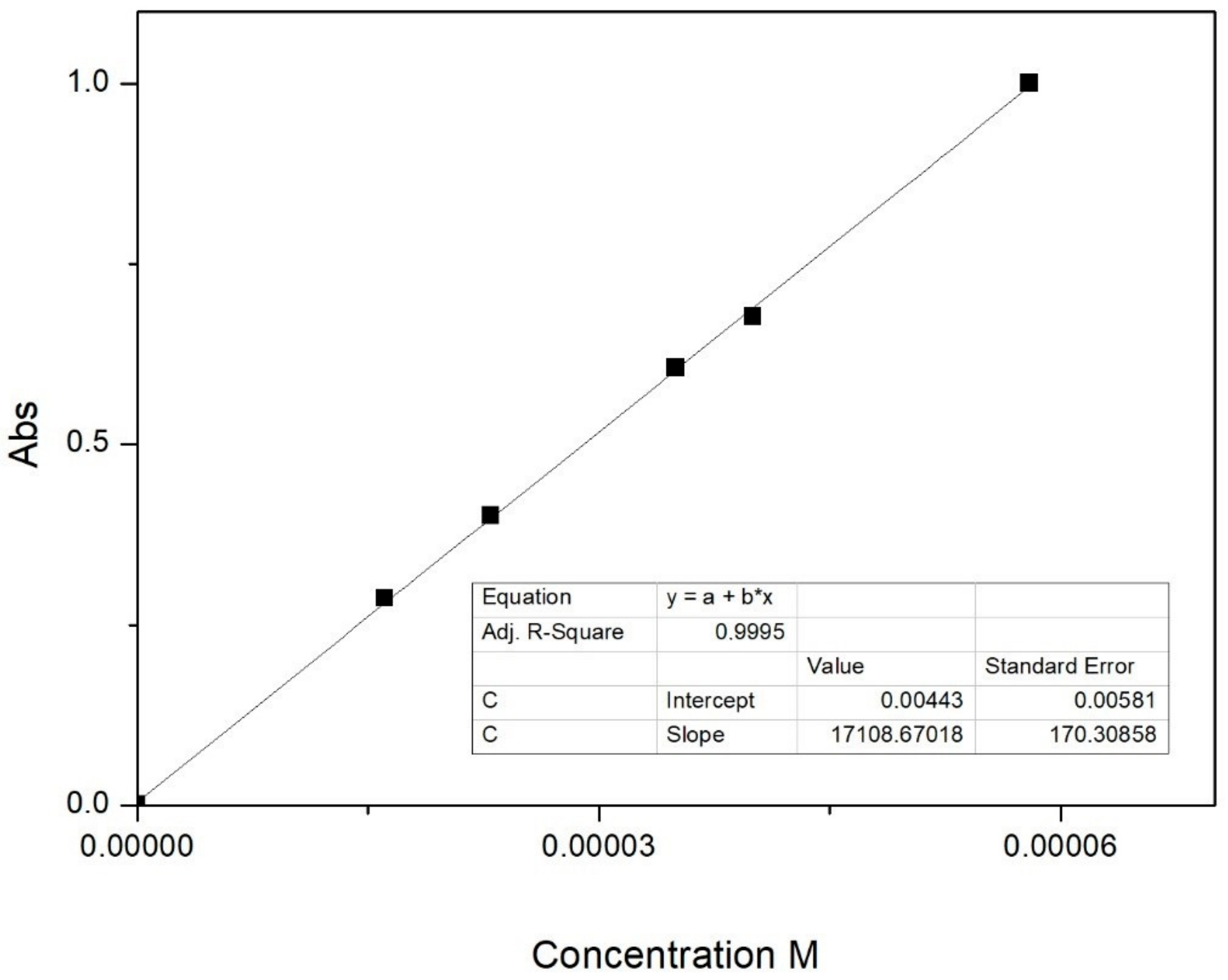
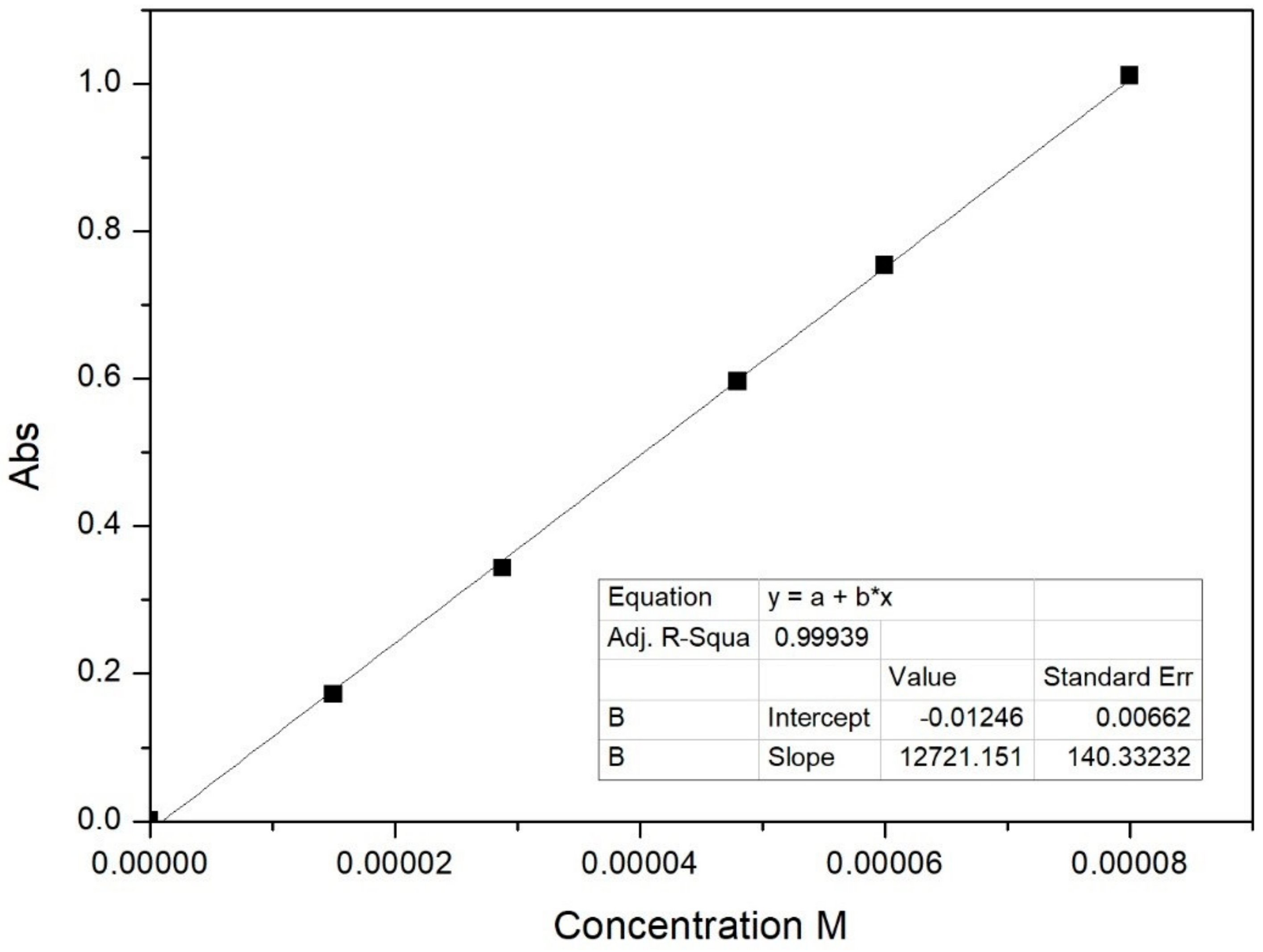
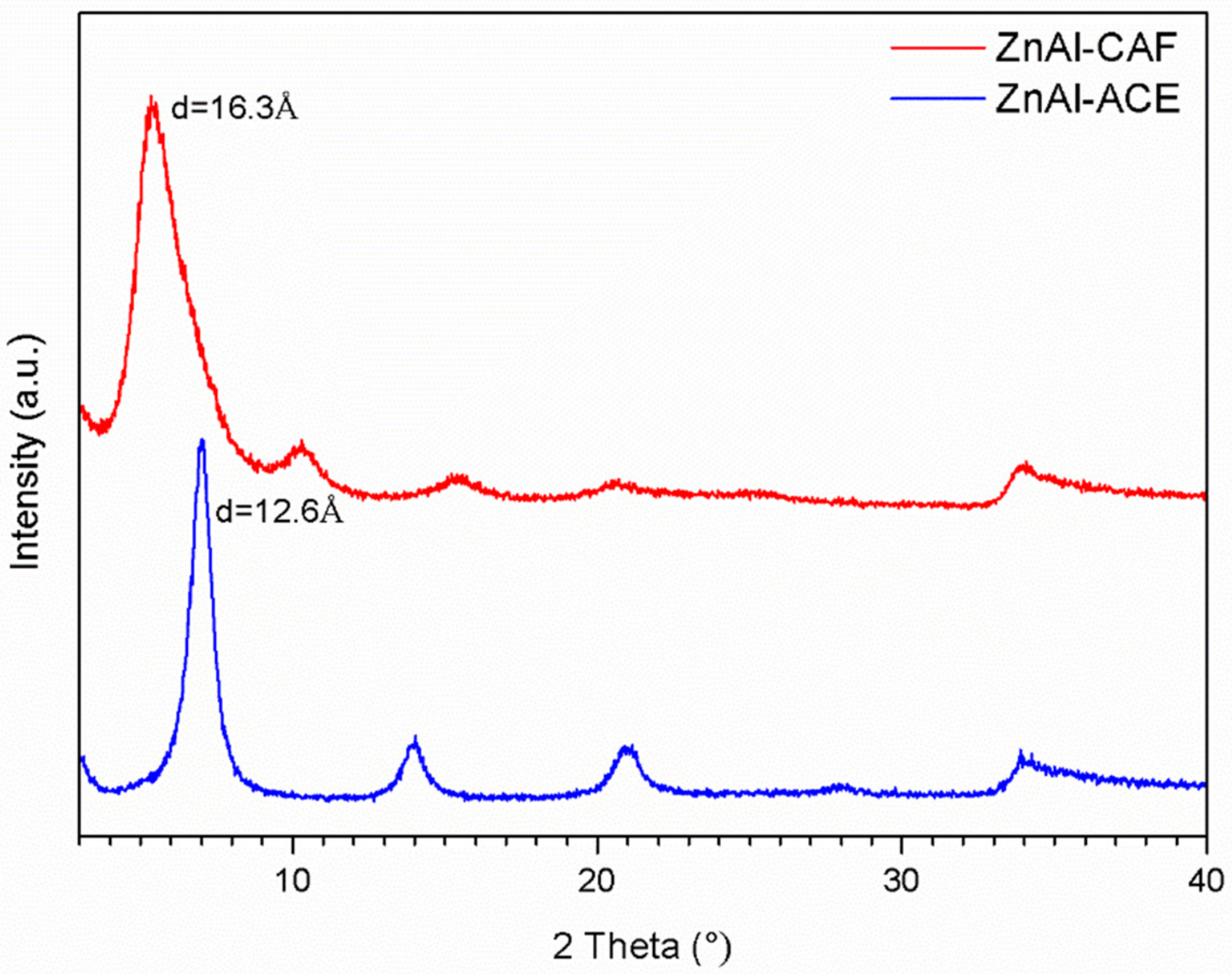

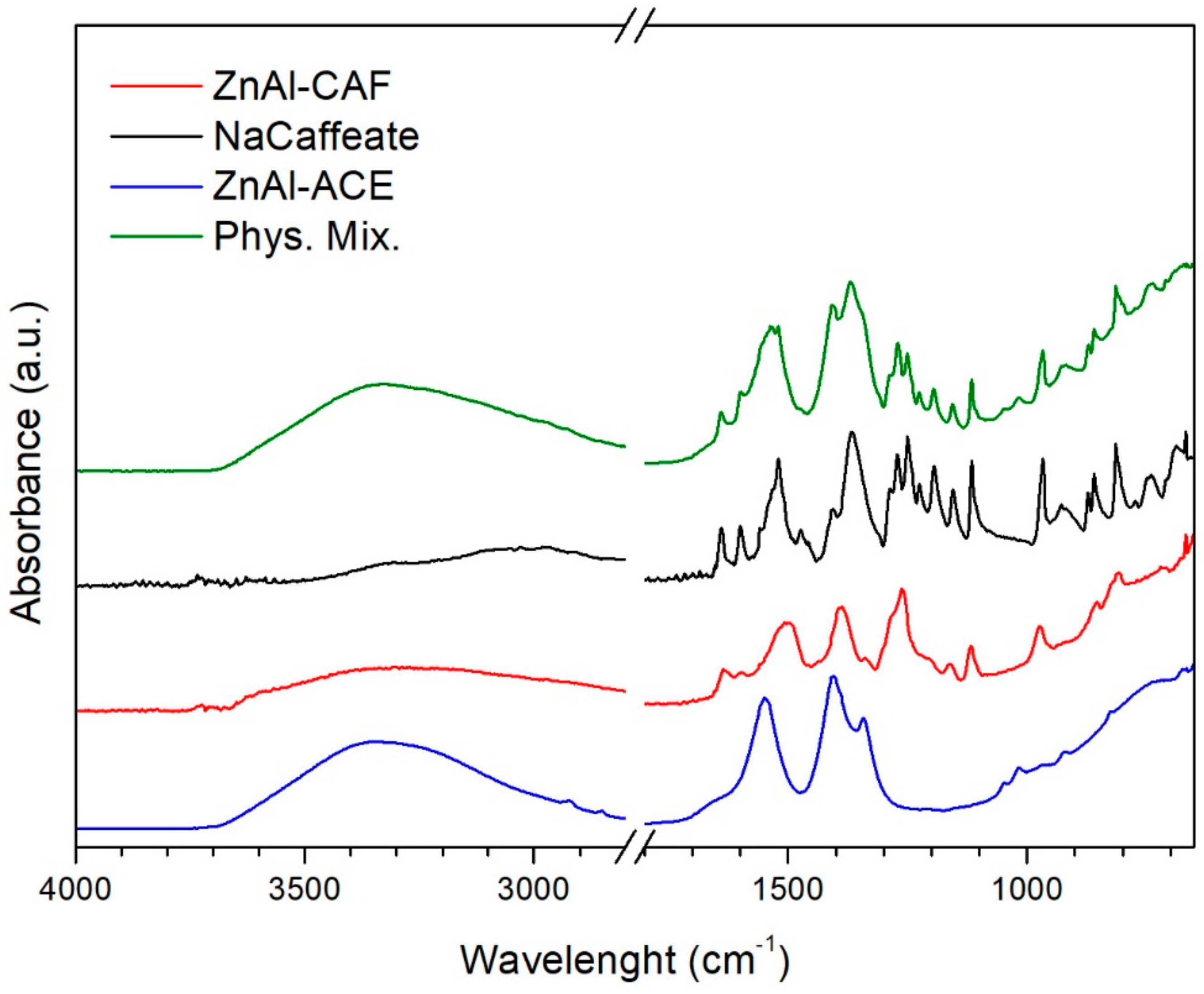
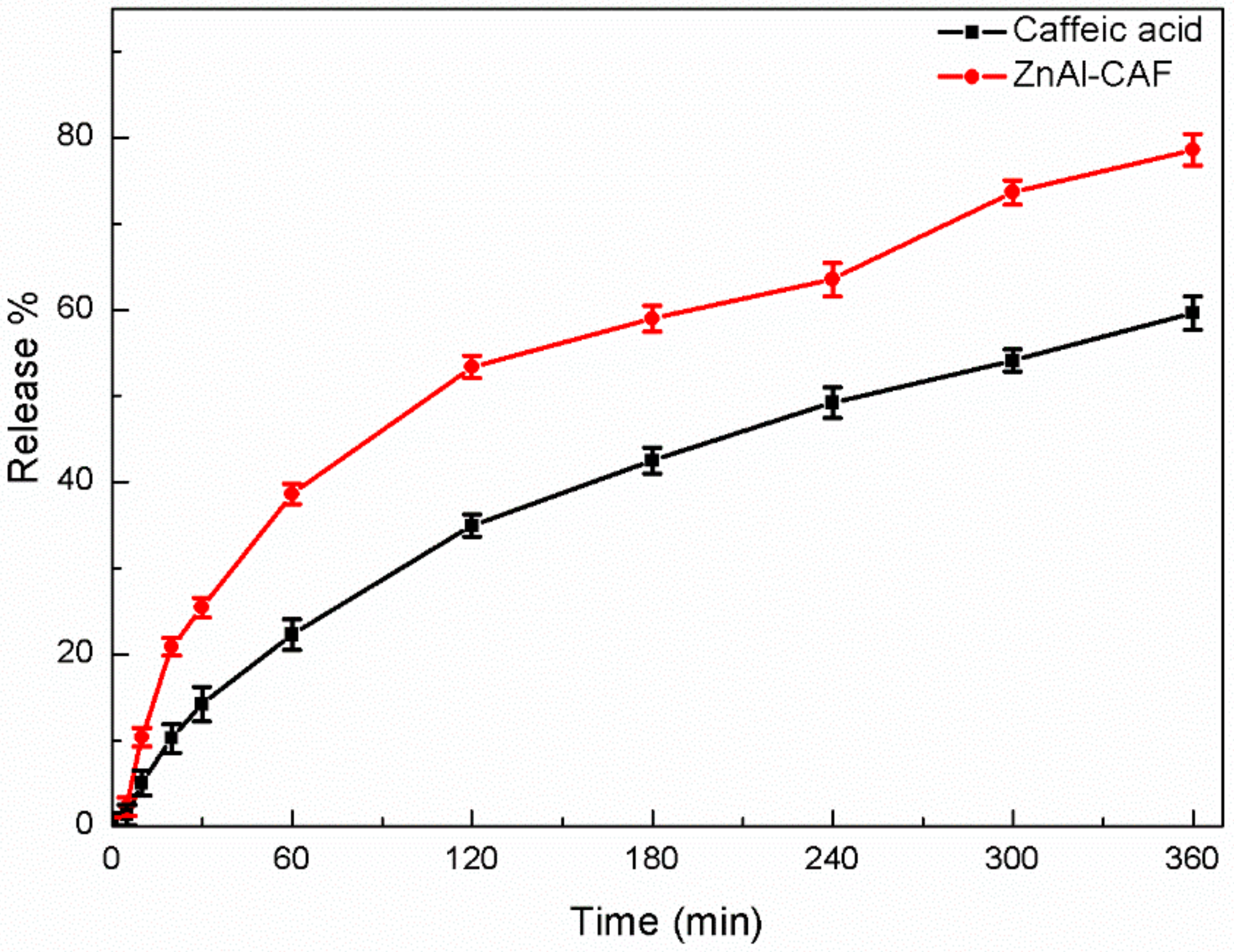
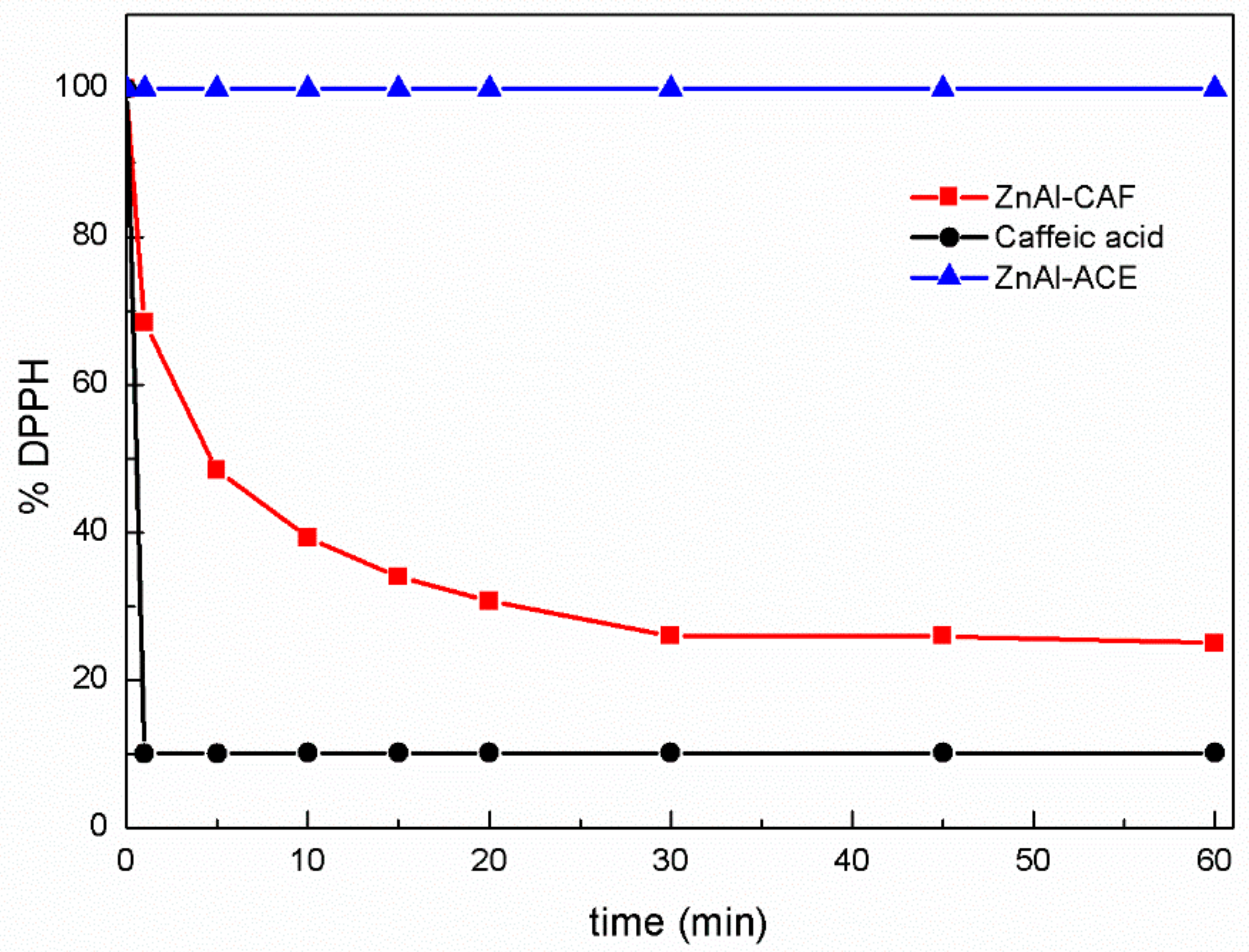
© 2018 by the authors. Licensee MDPI, Basel, Switzerland. This article is an open access article distributed under the terms and conditions of the Creative Commons Attribution (CC BY) license (http://creativecommons.org/licenses/by/4.0/).
Share and Cite
Bastianini, M.; Faffa, C.; Sisani, M.; Petracci, A. Caffeic Acid-layered Double Hydroxide Hybrid: A New Raw Material for Cosmetic Applications. Cosmetics 2018, 5, 51. https://doi.org/10.3390/cosmetics5030051
Bastianini M, Faffa C, Sisani M, Petracci A. Caffeic Acid-layered Double Hydroxide Hybrid: A New Raw Material for Cosmetic Applications. Cosmetics. 2018; 5(3):51. https://doi.org/10.3390/cosmetics5030051
Chicago/Turabian StyleBastianini, Maria, Caterina Faffa, Michele Sisani, and Annarita Petracci. 2018. "Caffeic Acid-layered Double Hydroxide Hybrid: A New Raw Material for Cosmetic Applications" Cosmetics 5, no. 3: 51. https://doi.org/10.3390/cosmetics5030051
APA StyleBastianini, M., Faffa, C., Sisani, M., & Petracci, A. (2018). Caffeic Acid-layered Double Hydroxide Hybrid: A New Raw Material for Cosmetic Applications. Cosmetics, 5(3), 51. https://doi.org/10.3390/cosmetics5030051




